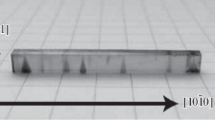Abstract
The property of solid hydrogen (H2, HD and D2) not to wet an attractive substrate, can be used to prepare micron sized hydrogen crystals. We used surface acoustic waves (SAW) in the range from 100 MHz to 1 GHz to study the elastic properties of the crystallite-substrate system. The growth of crystallites at temperatures around 3 K can be monitored by the resonant coupling of elastic eigenmodes to the SAW. We observed drastic changes of the resonant coupling for all isotopes when the temperature was varied between 0.15 K and 2.4 K. Possible origins of this unexpecied effect are discussed including a temperature variation of the wetting behavior. For H2 the impact of the ordering transition of ortho-H2 was also investigated.
Similar content being viewed by others
References
Unless explicitely specified, we denote by hydrogen all three stable isotopes H2, HD and D2.
A. D. Migone, A. Hofmann, J. G. Dash, and O. E. Vilches,Phys. Rev. B 37, 5440 (1988).
P. Leiderer and U. Albrecht,J. Low Temp. Phys. 89, 229 (1992).
U. Albrecht, P. Evers, and P. Leiderer,Surf. Sci. 283, 419 (1993).
R. N. J. Conradt, U. Albrecht, S. Herminghaus, and P. Leiderer,Physica B 194–196 679 (1994).
J. Classen, K. Eschenröder, and G. Weiss,Ann. Phys. (Leipzig) 4, 1 (1995).
J. Classen, K. Eschenröder, and G. Weiss,Phys. Rev. B 52, 11475 (1995).
M. Wagner and D. M. Ceperley,J. Low Temp. Phys. 102, 275 (1996).
M. Maruyama, M. Bienfait, F. C. Liu, Y. M. Liu, O. E. Vilches, and F. Rieutord,Surf. Sci. 283, 333 (1993).
J. Classen, K. Eschenröder, and G. Weiss,Physica B 219&220, 678 (1996).
G. Weiss, K. Eschenröder, H. Kiefhaber, and J. Classen,Czech. J. Phys. 46, Suppl. Sl. 527 (1996).
W. R. Smith, inPhysical Acoustics Vol. XV, W. P. Mason and R. N. Thurston (Eds.), Academic Press, London (1981).
B. A. Auld,Acoustic Fields and Wares in Solids Vol. II, 2nd edition, R. E. Krieger Publ. Co., Malabar, Florida (1990).
P. A. Bezuglyi and R. Kh. Minyafaef,Sov. Phys. Solid State 9, 2854 (1968); P. A. Bezuglyi, R. O. Plakhotin, and L. M. Tarasenko,Soc. Phys. Solid State 13, 250 (1971).
R. Wanner and H. Meyer,J. Low Temp. Phys. 11, 715 (1973).
“Simultancous” means that the measurements were done in a rapid succession of different frequency settings. The time required to cycle through the six frequencies was about 1 2 s. i.e., very short compared to typical time scales of our experiments of several minutes or even hours.
A. A. Maradudin, P. Ryan, and A. R. McGurn,Phys. Rev. B 38, 3068 (1988).
B. Djafari-Rouhani and A. A. Maradudin,Sol. State Commun. 73, 173 (1990).
A. V. Shehegrov and A. A. Maradudin,Appl. Phys. Lett. 67, 3090 (1995).
V. P. Plessky and A. W. Simonian,Phys. Lett. A 155, 281 (1991).
E. A. Garova, A. P. Mayer, and A. A. Maradudin,Verhandl. DPG (VI) 31, 1343 (1996); E. A. Garova, A. P. Mayer, and A. A. Maradudin, to be published.
H. N. Lin, H. J. Maris, L. B. Freund, K. Y. Lee, H. Luhn, and D. P. Kern,J. Appl. Phys. 73, 37 (1993).
I. F. Silvera,Rev. Mod. Phys. 52, 393 (1980).
At the phase transition the quantization axes of theJ=1 rotational momenta orient along the four body diagonals of the fcc lattice, where the molecules belonging to different orientations occupy the four interpenetrating simple cubic sublattices.
R. Wanner, H. Meyer, and R. L. Mills,J. Low Tentp. Phys. 13, 337 (1973).
R. Banke, M. Calkins, and H. Meyer,J. Low Temp. Phys. 61, 193 (1985).
J. T. Birmingham, P. L. Richards, and H. Meyer,J. Low Temp. Phys. 103, 183 (1996).
K. Eschenröder, H. Kiefhaber, and G. Weiss, to be published.
M. Wagner and D. M. Ceperley,J. Low Temp. Phys. 94, 161 (1994).
V. V. Goldman,J. Low Temp. Phys. 36, 521 (1979).
S. I. Shevchenko,Fiz. Nik. Temp. 11, 660 (1985) [Soc. J. Low. Temp. Phys.,11, 363 (1985)].
Author information
Authors and Affiliations
Rights and permissions
About this article
Cite this article
Eschenröder, K., Kiefhaber, H., Weiss, G. et al. Elastic low temperature anomalies of solid hydrogen crystallites. J Low Temp Phys 109, 163–181 (1997). https://doi.org/10.1007/BF02396730
Received:
Revised:
Issue Date:
DOI: https://doi.org/10.1007/BF02396730




